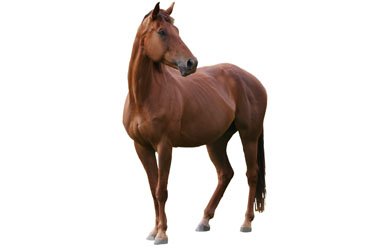How to Use Regenerative Medicine in Equine Practice

Just as regenerative medicine offers healing that appears almost miraculous for humans so can it do for for animals. The field is growing especially quickly for sporting horses, where the loss of ability can potentially cost the owner thousands or even millions of dollars.
What Is Regenerative Medicine?
“Regenerative medicine is the process of creating living, functional tissues to repair or replace tissue or organ function lost due to age, disease, damage or congenital defects. It includes the injection of stem cells or progenitor cells (also known as cell-based therapies), the induction of regeneration by biologically active molecules, and transplantation of in vitro grown organs and tissues,” according to The Ohio State University.
It is the same whether used on a human animal or another type.
Regenerative medicine includes:
- Stem cell therapy, which aids in tissue healing, such as damaged cartilage, fractures, desmitis (ligament inflammation), and more
- Platelet-rich plasma (PRP) therapy, which delivers a high concentration of platelets in blood plasma to a lesion to help the injury heal
- Interleukin-1 receptor antagonist protein (IRAP), which blocks interleukin-β-1 (a pro-inflammatory mediator) and reduces inflammation in joints, potentially decreasing lameness while increasing growth factor levels to promote cartilage and tendon healing
How Can Regenerative Medicine Help?
Regenerative medicine is showing promise in encouraging healing for wounds and tissue injuries. For horses, it may promote healing for:
- Tendon injuries
- Ligament injuries
- Arthritis and other inflammatory diseases
- Healing open wounds
- Skin grafts
Research indicates an added benefit may be lower rates of injury after treatment with mesenchymal stem cells (MSCs).
Using Stem Cells in Your Practice
Since 2003, veterinarians have used autologous adipose-derived mesenchymal stem cells to treat tendon and ligament injuries and joint disease in horses. The procedure involves:
- Extracting a fat sample
- Sending the sample to a laboratory for stem/stromal cell processing
- Injecting or placing the processed sample upon receipt
Collection of stem cells for MSC therapy involves harvesting cells from bone marrow or fat, depending on the treatment methods.The horse receives general anesthesia and remains standing.
- For marrow-derived stem cells, aspirate a sample of bone marrow from the horse's sternum. It's couriered to a laboratory. At the laboratory, stem cells are extracted, cultured, recombined with the serum and returned. Expansion can take two to three weeks.
- For fat-derived stem cells, make an incision, usually near the horse's tailhead, and collect a sample of fat tissue. At the lab, it's treated with enzymes and nucleated cells are separated from the fat. At this point, you have 2 options: The nucleated cell fraction can be sent back for use within three days or kept and cultured to get a higher concentration of MSCs.
Research indicates that the most efficacious method is to inject the stem-cell product directly into the injured tissue, using ultrasound to guide the injection. Delivering the treatment into the blood supply around the site using regional limb perfusion may not be as effective.
With recent advancements stem cell and other regenerative medicine therapies can now be conducted within the practice or stall side. Readily available stem cell kits provide greater access and convenience for the practicing veterinarian while making these treatments more affordable to the client.
Laboratories
Because many aspects of regenerative medicine, especially stem cell therapy, are so new, it may be difficult to find a laboratory. Call your local university with a veterinary program and ask.
An option for processing marrow-derived stem cells is Equine Partners America, LLC, a subsidiary of VetCell, which developed the process. For fat-derived stem cells, try Vet-Stem, a leading provider of this service.
Interested in More Information to Benefit Your Practice?
These articles may offer information of benefit to you.
EPM Treatment and Prognosis
New Treatment Option for Navicular Syndrome
Growing Role of Technology in a Veterinary Practice
Engaging, Educating Staff and Data Tracking
Find more information that may be helpful on our website or contact us online or at 855.724.3461.
Sources:
https://medicine.osu.edu/regenerativemedicine/pages/index.aspx
http://www.thehorse.com/articles/36804/current-applications-of-equine-regenerative-medicine
https://practicalhorsemanmag.com/health-archive/cutting-edge-cell-based-therapies-for-horses


Working Here
Our team members are encouraged to be the best they can be... at Covetrus we believe we impact one another.
Learn MoreNews & Events
FDA Cautions Pet Owners Not to Feed Texas Tripe Inc. Raw Pet Food Due to Salmonella, Listeria Monocytogenes
The U.S. Food and Drug Administration is cautioning pet owners not to feed their pets any of the Texas Tripe brand raw frozen pet food listed below because several samples of Texas Tripe raw pet food have tested positive for Salmonella and/or L. mono.
Careers
Are you looking for a place to let your talents shine? At Covetrus, we help our practitioner customers better serve their patients and take pride in providing the best customer experience possible. Search our open positions to see our available opportunities.
Newsletter
Stay current with what’s going on with Covetrus, subscribe to receive our newsletter and email communications. Subscribers will receive the latest information in practice management, sales and marketing, animal health, and more.



-3-(1).png?sfvrsn=2d806d73_0)

Leave a comment